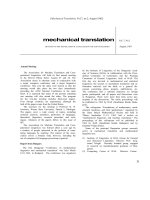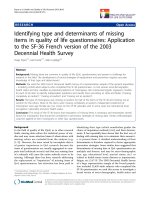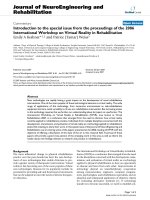báo cáo hóa học: " Welcome to the Journal of Neuroinflammation! " doc
Bạn đang xem bản rút gọn của tài liệu. Xem và tải ngay bản đầy đủ của tài liệu tại đây (199.45 KB, 3 trang )
BioMed Central
Page 1 of 3
(page number not for citation purposes)
Journal of Neuroinflammation
Open Access
Editorial
Welcome to the Journal of Neuroinflammation!
Robert E Mrak*
1
and W Sue T Griffin
2
Address:
1
Professor of Pathology, University of Arkansas for Medical Sciences, Little Rock, Arkansas, USA and
2
Professor of Geriatrics, University
of Arkansas for Medical Sciences, Little Rock, Arkansas, USA
Email: Robert E Mrak* - ; W Sue T Griffin -
* Corresponding author
Abstract
Welcome to the Journal of Neuroinflammation, an open-access, peer-reviewed, online journal that
focuses on innate immunological responses of the central nervous system, involving microglia,
astrocytes, cytokines, chemokines, and related molecular processes. 'Neuroinflammation' is an
encapsulization of the idea that microglial and astrocytic responses and actions in the central
nervous system have a fundamentally inflammation-like character, and that these responses are
central to the pathogenesis and progression of a wide variety of neurological disorders. This
concept has its roots in the discoveries of inflammatory cytokines and proteins in the plaques of
Alzheimer disease, and these ideas have been extended to other neurodegenerative diseases, to
ischemic/toxic diseases, to tumor biology and even to normal brain development. The Journal of
Neuroinflammation, published by BioMed Central, will bring together work focusing on microglia,
astrocytes, cytokines, chemokines, and related molecular processes in the central nervous system.
All articles published in the Journal of Neuroinflammation will be immediately listed in PubMed, and
access to published articles will be universal and free through the internet.
Introduction
There was a time, not too long ago, when chronic diseases
such as Alzheimer's disease were thought of entirely in
terms of neuronal toxicity, neuronal dysfunction, and
neuronal disappearance. Any associated glial responses
were dismissed as "reactive gliosis", not worthy of further
serious attention. How times have changed! The identifi-
cation of potent immunomodulatory cytokines, such as
interleukin-1, and inflammatory proteins, such as com-
plement, in the plaques of Alzheimer's disease has revolu-
tionized our thinking about this and other chronic
"neurodegenerative" diseases. Microglia and astrocytes
have come to be recognized as active participants in these
diseases, responding to neuronal insults in a decidedly
immunological fashion. And - as is the case in peripheral
inflammatory diseases where lack of resolution and the
resulting chronic inflammation can promote rather than
resolve injury, and create entirely new diseases in the proc-
ess - chronic, sustained microglial and astrocytic
responses in the brain promote rather than resolve injury,
and create disease in their misdirected efforts. This new
understanding of innate immune responses in the brain
and their potential for promoting chronic disease has lead
directly to a new concept in neurobiology: neuroinflam-
mation.
What is neuroinflammation?
'Neuroinflammation' encapsulates the idea that micro-
glial and astrocytic responses and actions in the central
nervous system have a fundamentally inflammation-like
character, and that these responses are central to the
pathogenesis and progression of a wide variety of neuro-
logical disorders. This idea originated in the field of Alzhe-
imer's disease [1,2] , where it has revolutionized our
Published: 20 April 2004
Journal of Neuroinflammation 2004, 1:1
Received: 30 March 2004
Accepted: 20 April 2004
This article is available from: />© 2004 Mrak and Griffin; licensee BioMed Central Ltd. This is an Open Access article: verbatim copying and redistribution of this article are permitted in
all media for any purpose, provided this notice is preserved along with the article's original URL.
Journal of Neuroinflammation 2004, 1 />Page 2 of 3
(page number not for citation purposes)
understanding of this disease [3]. These ideas have been
extended to other neurodegenerative diseases [4-6], to
ischemic/toxic diseases [7,8], to tumor biology [9] and
even to normal brain development. Neuroinflammation
incorporates a wide spectrum of complex cellular
responses that include activation of microglia and astro-
cytes and elaboration of cytokines and chemokines, com-
plement proteins, acute phase proteins, oxidative injury,
and related molecular processes. These events may have
detrimental effects on neuronal function, leading to neu-
ronal injury with, consequently, further glial activation
and ultimately neurodegeneration.
Neuroinflammation is a new and rapidly expanding field
that has revolutionized our understanding of chronic neu-
rological diseases. This field encompasses research rang-
ing from population studies to signal transduction
pathways, and investigators with backgrounds in fields as
diverse as pathology, biochemistry, molecular biology,
genetics, clinical medicine, and epidemiology. Important
contributions to this field have come from work with pop-
ulations, with patients, with postmortem tissues, with ani-
mal models, and with in vitro systems.
The Journal of Neuroinflammation
The new and rapidly expanding field of neuroinflamma-
tion deserves a journal of its own, to bring together work
focusing on this new area. The Journal of Neuroinflamma-
tion will provide this, together with the instant conven-
ience of online publishing and the universal availability
of open access. Edited by Robert E. Mrak and Sue T. Grif-
fin, Journal of Neuroinflammation is supported by an inter-
national Editorial Board. The Journal of Neuroinflammation
will publish original research articles (as full-length or
short reports) and comprehensive, authoritative reviews.
Commentaries, hypothesis papers, and occasional rele-
vant case reports will also be considered.
All published articles will be listed in PubMed immedi-
ately upon acceptance (after peer review). Submitted
manuscripts will be assigned to members of the Editorial
Board for review, or to alternative or additional consult-
ants expert in the topic of the manuscript, as deemed
appropriate by the Editors-in-Chief. Peer reviewers' com-
ments will be made available anonymously to authors.
The Editors-in-Chief will provide instructions for those
manuscripts requiring revision for final consideration.
Final decisions on suitability for publication rest with the
Editors-in-Chief.
Open Access
The Journal of Neuroinflammation is an open access journal.
Open Access policy changes the way in which articles are
published. First, all articles become freely and universally
accessible online, and so an author's work can be read by
anyone at no cost. Second, the authors hold copyright for
their work and can grant anyone the right to reproduce
and disseminate the article, provided that it is correctly
cited and no errors are introduced [10]. Third, a copy of
the full text of each Open Access article is permanently
archived in an online repository separate from the jour-
nal. Journal of Neuroinflammation's articles are archived in
PubMed Central [11], the US National Library of Medi-
cine's full-text repository of life science literature, and also
in repositories at the University of Potsdam [12] in Ger-
many, at INIST [13] in France and in e-Depot [14], the
National Library of the Netherlands' digital archive of all
electronic publications.
Open Access has four broad benefits for science and the
general public. First, authors are assured that their work is
disseminated to the widest possible audience, given that
there are no barriers to access their work. This is accentu-
ated by the authors being free to reproduce and distribute
their work, for example by placing it on their institution's
website. It has been suggested that free online articles are
more highly cited because of their easier availability [15].
Second, the information available to researchers will not
be limited by their library's budget, and the widespread
availability of articles will enhance literature searching
[16]. Third, the results of publicly funded research will be
accessible to all taxpayers and not just those with access to
a library with a subscription. As such, Open Access could
help to increase public interest in, and support of,
research. Note that this public accessibility may become a
legal requirement in the USA if the proposed Public
Access to Science Act is made law [17]. Fourth, a country's
economy will not influence its scientists' ability to access
articles because resource-poor countries (and institutions)
will be able to read the same material as wealthier ones
(although creating access to the internet is another matter
[18]).
The concept of neuroinflammation offers new hope for
understanding, prevention, and perhaps even cure of a
number of chronic neurodegenerative diseases. Join us in
this new field and this new endeavour! Publication is
prompt and reader access is worldwide and free.
Competing interests
None declared.
Acknowledgements
Supported in part by NIH PO1 AG 12411, NIH P30 AG19606, and NIH
RO1 AG 37989.
References
1. Griffin WST, Stanley LC, Ling C, White L, Macleod V, Perrot LJ,
White CL III, Araoz C: Brain interleukin 1 and S-100 immuno-
reactivity are elevated in Down syndrome and Alzheimer
disease. Proc Natl Acad Sci USA 1989, 86:7611-7615.
Publish with Bio Med Central and every
scientist can read your work free of charge
"BioMed Central will be the most significant development for
disseminating the results of biomedical researc h in our lifetime."
Sir Paul Nurse, Cancer Research UK
Your research papers will be:
available free of charge to the entire biomedical community
peer reviewed and published immediately upon acceptance
cited in PubMed and archived on PubMed Central
yours — you keep the copyright
Submit your manuscript here:
/>BioMedcentral
Journal of Neuroinflammation 2004, 1 />Page 3 of 3
(page number not for citation purposes)
2. Rogers J, Luber-Narod J, Styren SD, Civin WH: Expression of
immune system-associated antigens by cells of the human
central nervous system: relationship to the pathology of
Alzheimer's disease. Neurobiol Aging 1988, 9:339-349.
3. Akiyama H, Barger S, Barnum S, Bradt B, Bauer J, Cole GM, Cooper
NR, Eikelenboom P, Emmerling M, Fiebich BL, Finch CE, Frautschy S,
Griffin WST, Hampel H, Hull M, Landreth G, Lue L-F, Mrak R, Mac-
kenzie IR, O'Banion MK, Pachter J, Pasinetti G, Plata-Salaman C, Rog-
ers J, Rydel R, Shen Y, Streit W, Strohmeyer R, Tooyoma I, Van
Muiswinkel FL, Veerhuis R, Walker D, Webster S, Wegrzyniak B,
Wenk G, Wyss-Coray A: Inflammation and Alzheimer's dis-
ease. Neurobiol Aging 2000, 21:383-421.
4. Eikelenboom P, Bate C, Van Gool WA, Hoozemans JJ, Rozemuller JM,
Veerhuis R, Williams A: Neuroinflammation in Alzheimer's dis-
ease and prion disease. GLIA 2002, 40:232-239.
5. Orr CF, Rowe DB, Halliday GM: An inflammatory review of Par-
kinson's disease. Progr Neurobiol 2002, 68:325-340.
6. Ishizawa K, Dickson DW: Microglial activation parallels system
degeneration in progressive supranuclear palsy and cortico-
basal degeneration. J Neuropathol Exp Neurol 2001, 60:647-657.
7. Gehrmann J, Banati RB, Wiessner C, Hossmann KA, Kreutzberg GW:
Reactive microglia in cerebral ischaemia: an early mediator
of tissue damage? Neuropathol Appl Neurobiol 1995, 21:277-289.
8. Touzani O, Boutin H, Chuquet J, Rothwell N: Potential mecha-
nisms of interleukin-1 involvement in cerebral ischaemia. J
Neuroimmunol 1999, 100:203-215.
9. Graeber MB, Scheithauer BW, Kreutzberg GW: Microglia in brain
tumors. GLIA 2002, 40:252-259.
10. BioMed Central Open Access Charter [medcen
tral.com/info/about/charter]
11. PubMed Central [
]
12. Potsdam [ />]
13. INIST [ />]
14. e-Depot [
]
15. Lawrence S: Free online availability substantially increases a
paper's impact. Nature 2001, 411:521.
16. Velterop J: Should scholarly societies embrace Open Access
(or is it the kiss of death)? Learned Publishing 2003, 16:167-169.
17. Open Access law introduced [ />news/20030627/04]
18. Tan-Torres Edejer T: Disseminating health information in
developing countries: the role of the internet. BMJ 2000,
321:797-800.









